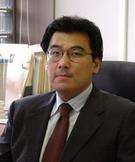I Want to Learn How to Think Beyond Academic Disciplines
Vol.8 2010.12.08 Kazuhiro UEDA
The Brain's Processing of Body Movements: Movements of Noh-Play as an Example
- What is Cognitive Science?
- Meanings of Thinking about Corporeality from Cognitive Science
- Presence of Embodied (Rarely Recognized) Knowledge
- Inseparability of the Body and the Knowledge (Brain)
- Corporeality in Japanese Traditional Performance Arts
- Particularity of Walk (Hakobi) in Noh-Play and Kyogen-Play
- Meanings of Sophistication (Iki) to Artistic Mastery
- Perfect Teamwork Bunraku Puppeteers
- Instructor
-

- Kazuhiro UEDA
- Professor at Interfaculty Initiative in Information Studies / Department of General Systems Studies, College of Arts and Sciences Professor at Graduate School of Interdisciplinary Information Studies / Department of General Systems Studies, Graduate School of Arts and Sciences My areas of specialty are Cognitive Science, Cognitive Brain Science and Intellectual Information Studies. My research scientifically looks at the intelligence of humans and society. I conduct my research on Cognitive Science and Cognitive Brain Science, aiming toward unraveling high level human cognitive activities, applying my findings to the field of engineering, and putting the findings into social use. Specific examples include: "Innovations Stemming from Ideas of Consumers," "Cognitive Structures of Creativity," "Order inside the Brains of Individuals Highly Skilled at Speed Reading and Calculation with Abacus," "Animacy Perception for Artificial Objects," "Human Perceptions of Sociality in Relation to Visual, Biological Motion, and Other Forms of Cognition," ad "Inter-human Collaboration." I have received awards such as the 7th Docomo Mobile Science Prize Excellence Award (2008), Best Paper Prize from the Japanese Cognitive Science Society (2004 and 2007), and Excellent Paper Prize from the Japanese Association of Educational Psychology (2007).
- Resume Download
comments(最新2件 / 4)
- 2010年12月14日 01:33 reply
日本の伝統芸能における身体のお話、非常に興味深く伺いました。
私が特に関心を持ったのは、能楽における身体・運動の持つ意味についてです。能楽に対し、また、歌舞伎に対し、その伝統性や芸術性についてもそうだけれど、身体というテーマから語る・学ぶことをしたいと思っていました。
熟達者ほど、運動と呼吸との連関が希薄になる。そうして下半身の動きを際立たせず、運動を殺し、「動かぬ身体」として機能する。それは運動をより抽象的・シンボリックにするなんらかの身体表現だということ。
興味は尽きません。
自分でももっと考え続けていこうと思います。
- 2010年12月14日 21:09 reply
伝統芸能における身体運動について科学的な分析を加え考察することは、私が将来挑戦できたらなと感じていたことでしたので、非常に面白かったです。実際に動きを行っている人自身にとっては明確に意識に上っていないこと、言語として説明できないこと(「ず」とは具体的にどういったものであるのか、など)に”実際に体現する”のとは別の観点から触れるのはやはり刺激的だと思いました。(その一方で、何でも科学的な観点から解析的に見ることってなんだか”デリカシーがない”ような気がしてしまうのも確かなのです、面白いのですが)また、解析しようとすると処理が膨大であったり原因がよくわからない運動であっても、それを、自身では明確に言語で説明できない場合があるにもかかわらず身体運動として表現できることに対して感慨を覚えました。
意外だったことは、狂言においては熟達者ほど呼吸と運動が独立していたことです。武道などではむしろ熟達者ほど呼吸と運動が密接に関係していると思うのですが、狂言では全く逆なのですね。自分なりにその原因を考察してみたのですが、狂言の場合は運動以外に歌という要素が関わってくるため、(必ずしも舞の振りと歌のフレーズ・抑揚は合致しないかも知れませんから)呼吸が運動に引きずられることなく歌の表現の方に生かせるように、熟達するほど呼吸と運動が独立するのではないでしょうか。また武道の方は、呼吸による身体運動の調節に重点があることに加えて、剣道で打ち込むとき声を出すように、身体運動と強く関係した発声を行うために呼吸と運動が一致するようになると考えました。
今回の講義をきっかけに、より自分の考えを深められたと思います。今後もこのようなテーマのお話をお聞きできる機会があれば嬉しいです。
 2010年12月18日 00:35
reply
2010年12月18日 00:35
reply
700年もの間受け継がれ、洗練されてきた伝統芸能を、科学的に解析し人間の身体について考える。今回の講義は、大変興味深い内容でした。また、まさにご研究中で答えの出ていない問題を、学生に開き議論してくださるという点が挑戦的で、聞いていて興奮しました。
私が考えたことは、能や狂言の意味を加味すれば、この研究が更に深いものになるのではないかということです。例えば、能は神前で舞われ、幽霊を演じることが多いことから、能の型は、ただのパフォーマンス以上の意味を持つのではないかと考えられます。これは想像ですが、演じるというよりも、何らかの超自然的な存在が憑依するための「容れもの」になることが、能の目的なのかも知れないと思いました。このために、「個」を極限までそぎ落とし、呼吸も変化しないような身体を作り出す。だから能を舞う年齢のピークは他の身体運動よりもずっと晩年であり、演技の完成に身体と精神性の両方が要求されるのではないでしょうか。そのような型が、見る人を感動さえるのだとしたら、人の認知とそうやって創りだされる「容れもの」性というのが何らかの形で結びついている可能性が考えられますし、ご研究の中で、能が他の伝統芸能と異なる身体反応を示してたことも、うなずけます。また、この「容れもの」性から見て、人形なのに人間的な動きをする文楽と、人間なのに人形的な動きを追求する能は、面白い比較対象だと思いました。
この研究の今後の進展をまた講義で聞く日を楽しみにしています。
Post a Comment
- Other Lessons
本日の伝統芸能に関するおはなしは、私がまさに聞きたいとおもっていた内容でした。
伝統芸能のいわば「日本らしさ」をテクノロジーをつかって分析していくさまは興味深く、ある種シュールで聞いていて面白かったです。
また機会があれば、歌舞伎や他の国の芸能についてもお聞きしたいと思います。